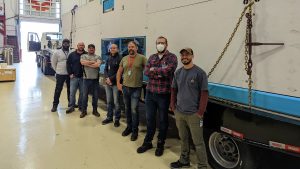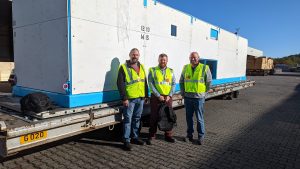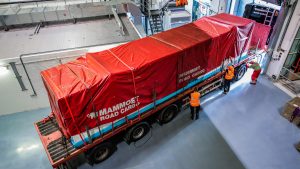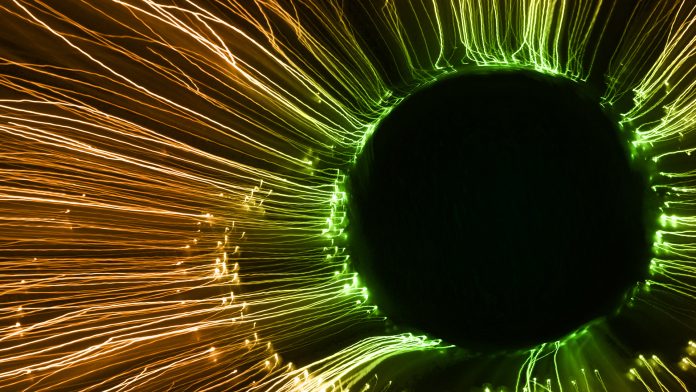Ahead of PIP-II’s cryomodule transportation test, Editor Maddie Hall spoke with Fermilab Scientist, Jeremiah Holzbauer, about the recent transportation tests, the progress of PIP-II, and the significance of the project for the field.
Particle physics seeks to answer fundamental questions about the nature of matter. The high-energy collisions created at particle accelerators provide us with the ability to measure incredibly elusive particles. Data gathered from these experiments has been invaluable in studying the inner workings of particles and greatly expanded our understanding of the universe.
One of the significant ongoing projects in the field of particle physics is the Proton Improvement Plan II (PIP-II) at Fermilab. PIP-II is an essential upgrade to Fermilab’s accelerator complex, preparing the facility for the next era of scientific discovery and enabling the world’s most intense high-energy beam of neutrinos. The project involves significant international collaboration, requiring precise and successful transport of parts across the globe. To prepare for this, Fermilab have carried out extensive planning and testing of the transportation method.
Ahead of the shipment of the prototype cryomodule, The Innovation Platform Editor, Maddie Hall, spoke with Fermilab Scientist, Jeremiah Holzbauer, about the recent transportation tests, the progress of PIP-II, and the project’s significance for the field.

Can you explain the PIP-II project at Fermilab? How will it work?
The Proton Improvement Plan-II project is part of the revitalisation of the Fermi National Accelerator Laboratory accelerator complex. The existing complex took 30-40 years to build, as technology, expertise and the needs of the scientific programme developed simultaneously. PIP-II is part of a wider effort to replace and upgrade the complex for future needs, to ensure it has the flexibility, reliability, power, and efficiency required to establish the machine as world-leading for the next generations.
To develop the next generation of intensity machines, more intense beams are required, and this will be made possible by PIP-II – more protons on target, faster. Think of the Fermilab accelerator complex as a well-loved race car; we’ve tuned and tweaked the performance for decades, and it’s one of the best in the world, but to reach the next level, now we need to start doing major replacements.
The goal of particle accelerators at this level is to pack as much energy as possible, in this case radio frequency (RF) energy, into a small space and efficiently transfer it to the protons as they pass through. The existing machine is based on copper structures, and though very efficient, it still has losses and we have reached the limit of what it can do.
To deliver the higher-intensity beams with more precision and flexibility, that machine will be replaced by a modern superconducting accelerator. Superconducting technology is a game changer as it can store energy extremely efficiently.
The PIP-II cavities can hold more energy more efficiently, and we can keep the cavities full of energy to accelerate without needing to empty them, as has been required by the copper machine it’s replacing. This enables us to concentrate a very high amount of RF energy in a very small space, getting more energy to more protons.

Last year, you successfully completed the transatlantic transportation test of the dummy load. Why is it important to conduct this test and what were the results?
Last year, the dummy load was shipped to our partners at STFC-UKRI in Daresbury, UK, and back. Other than excluding the internal parts of the cryomodule, the test was realistic and included the full transportation frame, isolation system and logistics, weather protection, handling, rigging, and customs.
The transportation test was a response to lessons learned from the previous LCLS-II project. The first LCLS-II module we transported arrived damaged in an unexpected way. This occurred when the production line already in motion. Production had to be put on hold, and it took over a year to diagnose and repair the issue, resulting in associated costs and delays to the schedule.
Consequently, transportation quickly became an important topic for discussion, and the focus turned to how this could be prevented in future, and what practices could be implemented, not just for LCLS-II or PIP-II, but broadly at Fermilab. Our work is incredibly specialised, meaning even a dedicated equipment transport company can’t be entirely relied on to move these things without some real risk of damage. We, as the experts, need to systematically mitigate the technical risks of transportation, starting at the design level, and that is what we have done for PIP-II.
The cryomodules are provided by our partners overseas and require intensive travel across the ocean as well as on site. Furthermore, it has to operate at two degrees above absolute zero, requiring specialised engineering, refrigeration, vacuum, and custom support systems, all of which has delicacies and can be vulnerable during transport. To create a robust transportation system we worked with our partners, collaborating to design not only the frame and the transportation method, but also an escalating set of tests.
This testing programme ensured we could understand and adapt to potential issues of transportation as they arose, without risking the device itself. Practicing the complex set of processes enabled us to assess major technical and scheduling risks, and track them throughout the test to assess the impact on cost and schedule.
Only a limited number of these cryomodules are made, and we operate with the principle that if one of them breaks, others will likely also break. The prototype enables us to learn our lessons early, before our partners begin production, and even before they start buying components. This grants us time to review and make any major changes if needed, mitigating considerable risk going forward.
Can you discuss the process and the objectives of the test of the first prototype cryomodule and its shipment in October?
In October, we will complete the same process as above with the addition of the cryomodule. Initially, we test the module at Fermilab by running in it as realistic an environment as possible, testing the superconducting cold parameters to the extent we can without a beam. It will then be shipped to the UK, with checks completed at various stages, before being shipped back to be tested again.
Due to its size, parts of the module have to be dismantled in the process. When it returns, it’s reassembled and tested for a couple of months, allowing for detailed rechecks of mechanical tuners, the vacuum, and cleanliness among many other things. This gives us a very thorough check for any potential transportation changes or damage. This extensive validation, both design and testing, is relatively novel, but ideally will become the gold standard for the design and transport of projects on this scale in the future.
We have already been able to use the expertise gained on LCLS-II and PIP-II to start collaborating with other large accelerator projects around the world, building a larger community of knowledge and lessons learned for this sort of delicate equipment transportation.
It is an incredibly exciting project, and the next step towards the future of particle accelerators and preparing for new levels of discovery. The transportations tests make this tangible, and after extensive planning and documentation, standing in front of this huge module with our partners from across the globe is truly momentous.

Countries around the world are contributing to the PIP-II project; how is this different to previous approaches? What are the advantages of this global, international collaboration?
International collaboration has unlocked access to a larger pool of experts, and enabled us to build a huge network, which is a phenomenal benefit. We get to leverage the experience of our partners, and build a valuable team with different expertise and perspectives. When we’re conducting analyses for methodology, logistics, procedures loading and unloading, the value of this wealth and variety of experience is exponential.
The collaborations for the experiments and the data analysis are international, resulting in very high-level testing, analysis, review, and the sharing of expertise between universities and labs. While this is an established tradition in high-energy physics, for particle accelerators – particularly in the US – the ability of multiple institutions to bring their fabrication facilities and expertise together at this scale is something we are only now leveraging.
Speaking more broadly about the neutrino programmes and upgrades at Fermilab (LBNF-DUNE, PIP-II, among others), it would be prohibitive for Fermilab alone to build and provide the facilities, expertise, and infrastructure. There are many labs and universities that can build or contribute to accelerator or detector components. These collaborations therefore allow us to leverage the partners that traditionally wouldn’t be involved in the experimental space.
This teamwork benefits the whole field going forward, granting a variety of technical expertise and flexibility not just for us, but also for our partners.
For example, Fermilab contributed cryomodules to FLASH at DESY in Hamburg, and it was fascinating to observe our engineers and technicians gain technical excellence by working on these modules. This excellence was then utilised for the LCLS-II modules for SLAC, then on the PIP-II modules for us, and so on.
Our cooperation also grants labs more access to the Deep Underground Neutrino Experiment and Long Baseline Neutrino Faculty collaborations. They can train their personnel, contribute at this high level, advance their facilities, and learn from us, just as we can from them.
The ultimate goal of these collaborations is to collect the lessons we have learned individually and build a communication network. Combining and exchanging world-leading technology, knowledge, equipment and techniques, is where the future of these projects lies.
Have you come across any challenges so far? What kind of issues can arise with a project of this scale and what steps do you take to mitigate these?
The PIP-II project is very technically challenging, but thanks to contributions from many high-level experts from around the world, the technological aspects are achievable. The main challenges concern documentation, communication, and logistics. In working with partners across the globe, consistency in communication and documentation are key in ensuring processes run smoothly. If communication and procedure aren’t established early on, problems will arise later.
For example, when procuring a piping system, it must comply with specific safety codes to be operated at Fermilab, requiring testing and certifications. To ensure our partners have the same understanding and compliance, this information must be documented clearly. We are actively collaborating with our partners to ensure that their designs are fabricated so they can both test them safely at their labs, and we can operate them safety at Fermilab.
The challenge of creating a machine of this size is also immense. Hundreds of thousands of components, all rigorously tested, have to come together and work as anticipated. Moreover, all of these components must be accompanied by the relevant documentation. Thus, without a coherent, established, documentation and communication system in place, it becomes significantly more complicated to ensure the processes run correctly and smoothly.
Working internally and with our partners to ensure this rigorous standard of documentation, communication and quality assurance has pushed Fermilab’s competence and excellence in project engineering and management to another level.
What is the importance of this project, and how will it be useful for other Fermilab experiments such as the Deep Underground Neutrino Experiment project?
Neutrinos are a significant focus of intensity frontier physics, and until recently, they were very difficult to study because there were very few interactions to measure, and the signals themselves are very subtle. To measure extremely rare interactions, an enormous number of particles must be sent into a very sensitive detector to gather enough statistics.
We now have the capability to measure neutrinos interactions, and want to complete more systematic studies to discover their basic properties. In order to do this, you have to build something like DUNE, an enormous, highly sensitive, liquid argon detector, situated underground to shield it from cosmic rays. Then, we push the intensity of our machine, continuing to increase the number of particles pushed through, and see the results.
However, the limitations of the existing machine and the intensity we can generate are becoming more noticeable. By replacing the oldest parts of the machine, PIP-II removes some limitations of the complex, granting us the ability to put significantly more particles on target, generating more data. Subsequent projects may replace the booster or upgrade the main injector, all with the same goal of increasing the intensity and improving the machine. PIP-II is not only designed to improve the complex now, but to work well with these future upgrades. This is the first step towards creating the accelerator of the next generations.
PIP-II will be transformative, allowing DUNE, the near site detector, and the LBNF collaboration in general, to deliver its goals in a reasonable amount of time. The faster data can be collected, the faster it can be synthesised and analysed to discover its significance. With PIP-II, we can collect a large set of measurements in only a couple of years, and use those results as a basis for what to adapt or study next.
To know exactly what particle physics experiments will be underway in 20 years is impossible, so PIP-II is the first step in providing an adaptable machine that can push intensity in a very flexible way. Essentially, it is a platform that the future of Fermilab can be built on.
The project is important for the modernisation and rejuvenation of Fermilab in general. For labs like Fermilab to succeed, the workforce, procedures, and processes have to be upgraded and rejuvenated alongside the machine itself; the entire lab has to be cutting edge.
As we are developing our technology, we are developing our workforce, and the new energy that accompanies every project and every new piece of technology is evident and exciting. LCLS-II started, and PIP-II has continued, to push Fermilab to more modern standards of project engineering, technical expertise, collaborative work environments, and new technologies.
Please note, this article will also appear in the sixteenth edition of our quarterly publication.




